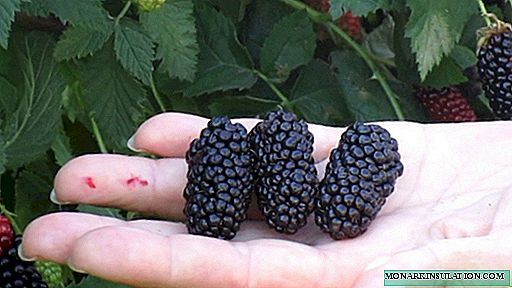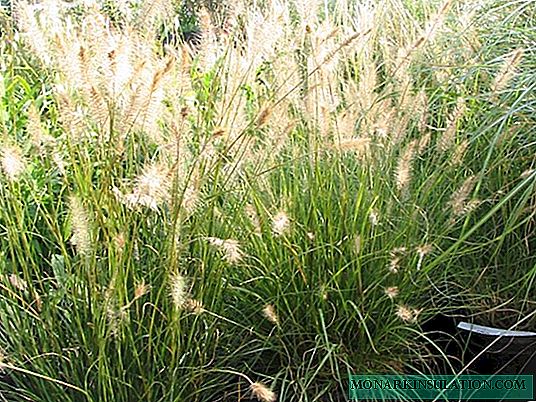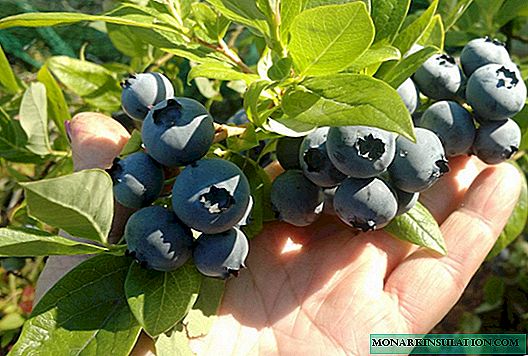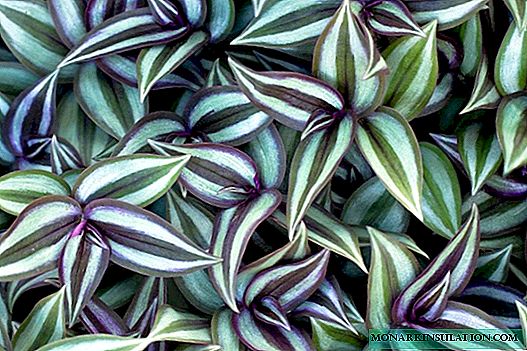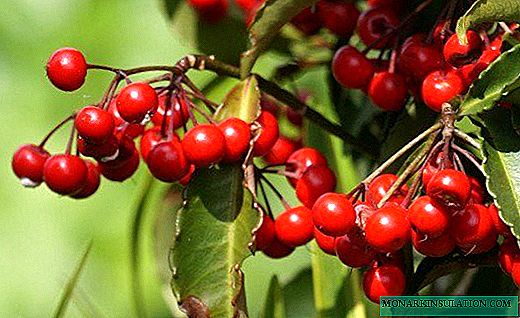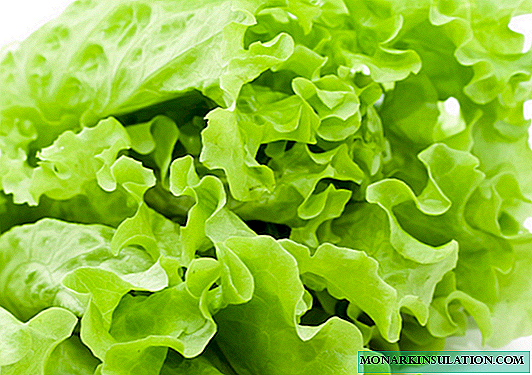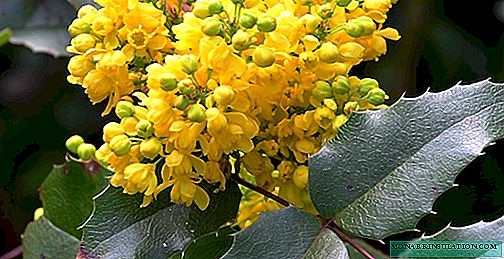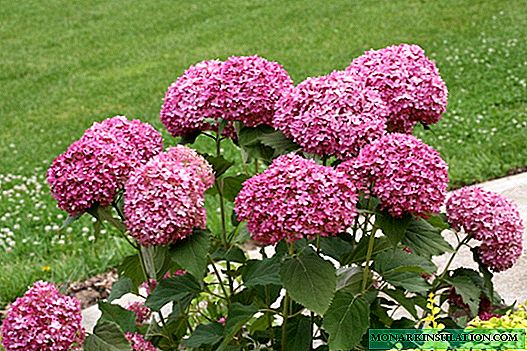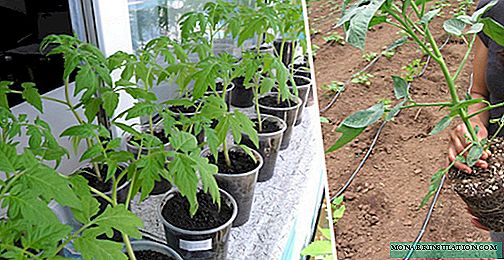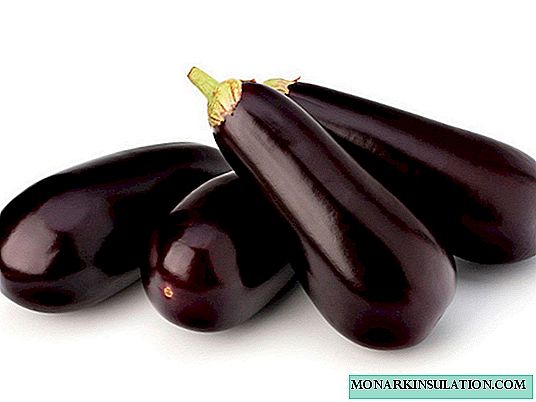
The Moscow Region is not very suitable for growing eggplants: they need a long warm summer, and in the Moscow Region up to 2/3 of the sunlight is absorbed by the clouds. However, in greenhouses, this culture feels normal. Achievements of breeders allow you to grow early varieties in the open field, but this is a very risky task, although in the south of the Moscow Region eggplants in the garden have time to grow almost any summer.
The best varieties for Moscow region
Since the cultivation of eggplant in the Moscow Region depends on how warm the season is, they try to plant the most cold-resistant varieties of early ripening. Among suitable varieties and hybrids, for example, Giselle F1, Agat F1, Alyonka are popular, varieties zoned for the North-West and Ural regions also grow well. Under the beds choose the warmest areas, but in any case, the eggplant in the open ground is initially planted under light shelters.
Eggplant for open ground
For such a capricious crop as eggplant, in the risky farming zone it is better to use hybrids (F1), but some old varieties are almost as good as them. Now a huge number of options are offered, but we must clearly understand that in the Moscow Region, if you want to grow eggplants in unprotected soil, you need to choose early or even super-early varieties and hybrids. In an extreme case, you can plant mid-early, but they will require more careful care.
- Agate F1 - a high-yielding hybrid, has such a short growing season that sometimes it can do without seedlings: at the end of May, you can try to sow seeds under the film, until the first frost, the main part of the crop will ripen. Fruits are traditional for eggplant form and color, weighing 200-250 g, high yield. The variety is resistant to disease.

Agate F1 is one of the few hybrids that can be grown in a seedless way.
- Sancho Panza is a tall variety, bearing spherical eggplants of dark purple color weighing more than half a kilogram. The variety is undemanding to conditions, the plant does not die at low positive temperatures, it is also grown in Siberia. Productivity up to 9 kg / m2.
- Bull Heart F1 - a mid-early hybrid, the fruits can be removed 4 months after sowing the seeds. A tall bush requires binding, the fruits are oval, weighing 300-400 g, shiny. Sickly hybrid, fruiting is extended.
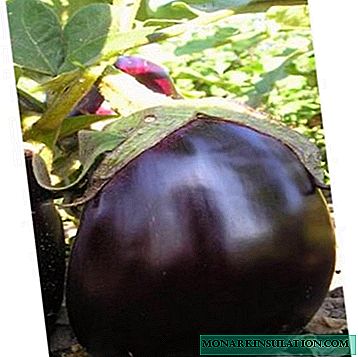
Eggplant Bull Heart was named for the size and shape of the fruit
- Galina F1 - an early hybrid, tall. Fruits are cylindrical, up to 15 cm long, weighing 200-300 g, glossy. The pulp is almost white, of refined taste. Productivity is high.
- Esaul F1 - a hybrid of medium maturity, medium-sized bushes. The fruits are very thin: up to 15 cm long, but only 3 cm in diameter. The maximum mass of the fruit is 200 g, and the average yield. The pulp is greenish, very tasty.
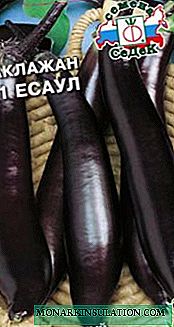
Esaul has very slender fruits
- Emerald F1 - eggplant with mushroom aroma and taste, is characterized by increased cold and disease resistance. 100-110 days pass from sowing seeds to harvesting fruits. Fruits are green, oval, weighing up to 300 g. It is considered one of the most non-whimsical hybrids, capable of bearing fruit in any weather conditions.

Eggplant Emerald F1 is not at all "eggplant" in the color of delicious fruits
- Lava F1 is a high-yielding hybrid, the first fruits ripen relatively early, but fruiting continues until frost. The fruits are small, up to 150 g, cylindrical, glossy. With careful care, it shows high productivity.
- Bourgeois F1 is a tall early ripe hybrid. The bush is very high, requires compulsory formation, but it is characterized by the highest resistance to diseases and prolonged fruiting. The fruits are large, weighing up to 500 g, similar in shape to tomatoes, are well transported and stored for a long time. The purpose of the crop is universal.

Bourgeois fruits resemble almost black tomatoes
- Negus is a super early variety, its bushes grow to a maximum of 60 cm in height, are cold-resistant. The fruits are barrel-shaped, almost black, weighing from 150 to 300 g, high yield, good taste. Fruits up to the onset of frost, the purpose is universal.
- The king of the north F1 is a hybrid with conflicting reviews. Since it is popular even in Siberia, the number of opinions about it is great: for some reason, from enthusiastic to "nothing special." Able to bear fruit at very low temperatures; on the contrary, does not like intense heat. Productivity reaches 14 kg / m2 - one of the highest for culture. From seedlings to the readiness of the first harvest takes about three months. The fruits are large, very long and thin, not bitter.
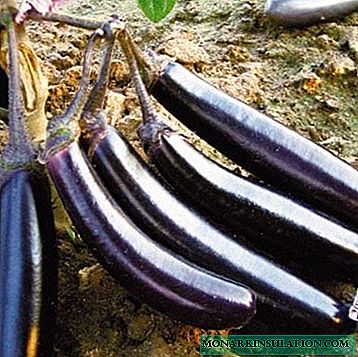
The King of the North has long fruits, often even lying on the ground
Eggplant for the greenhouse
It would seem that any eggplant can be planted in the greenhouse. But, firstly, late-ripening varieties in the suburbs may not mature in the greenhouse. Secondly, saving space, gardeners try to grow tall and productive varieties and hybrids in greenhouse conditions.
- Vakula - a variety of early ripening, grows a tall bush with many fruits. Productivity up to 13 kg / m2. Fruits are elliptical, wide, weighing 300-400 g. Almost the entire crop ripens at the same time, is well stored and transported. The variety is disease resistant.
- Giselle F1 is a hybrid, universal both in terms of fruit use and growing conditions. In good greenhouses yield up to 14 kg / m2, in unprotected soil below. Fruits weighing up to 500 g, cylindrical, standard for eggplant coloring, are stored for a long time. The first harvest is about 110 days after sowing the seeds.

Giselle - one of the most popular eggplants in the Moscow region
- Alyonka is one of the best varieties for the middle band, bearing fruit in bright green eggplant. Light green pulp gives very much mushrooms. Fruits weighing up to 300 g, average yield, about 3.5 months pass from sowing seeds to harvesting.
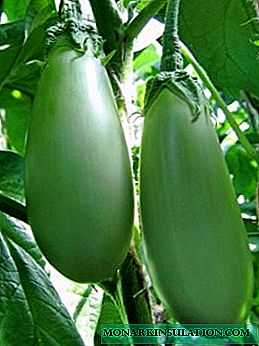
Alyonka is a rare representative of green eggplant
- Don Quixote is an early ripe variety for all types of greenhouses. The shape of the fruit is somewhat unusual: elongated eggplants up to 40 cm long expand downward. The mass of the fruit is 200-300 g, the taste is excellent, the number of seeds is very small. The purpose is universal.
- Romantic - an early ripe variety with fruits of soft lilac color and oval shape. Bushes up to a meter tall, average productivity. The variety is capricious, can be grown only in good greenhouses: it gets easily sick with fungal diseases during cold snap.
- Balagur - a variety of early maturity, after sowing the seeds, the fruits are ready for harvesting after 90 days. The bushes are tall, covered with lilac fruits: on one bush they can grow up to 100 pieces. However, each instance weighs only about 100 g. The taste is excellent. The variety is famous for its increased resistance to colds and diseases, but it requires skilled bush formation.
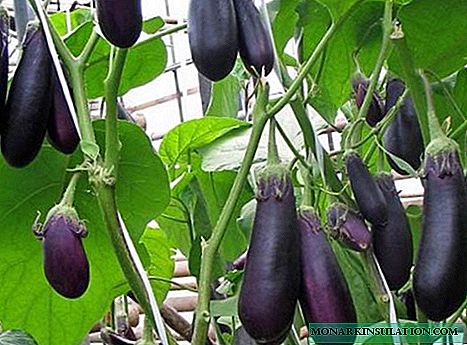
Balagur’s fruits are not very large, but there are a lot of them on the bush
Growing conditions
It takes a lot of time from sowing seeds to harvesting eggplants: the most early ripening varieties bear fruit only after three months or more, and the usual norm is 4-5. In this connection, I would like to quickly plant this vegetable in the garden, but you can’t: it needs real warmth. Even in the south, seedlings have to be prepared for early production, and in the Moscow Region this is a mandatory procedure, and this work begins in the winter.
It would seem that eggplant does not need anything special: you need warmth, a lot of moisture and very fertile soil. That is the heat lovingness, coupled with a long growing season, and stops the advancement of culture to the north. It is the difficulties with agricultural technology that lead to the fact that far from every gardener near Moscow undertakes to grow blue ones.
Growing seedlings
Growing eggplant seedlings, in fact, is divided into two unequal phases: at first everything goes very tight, and when the seedlings grow older, caring for seedlings is no more difficult than for tomato. Not every summer resident dares to do this: the blue seedlings require a lot of attention and patience.
When to plant eggplant for seedlings
Eggplant seeds are slow-witted: untrained sprouts take a very long time, and prepared ones do this not like other crops. The first seedlings, which are well worked on, may appear in a week, and then another ten days may appear the following. Therefore, one has to start preparing for seedling in the winter, regardless of whether greenhouse eggplant cultivation or transplanting seedlings into open ground is supposed.
It is believed that many modern varieties can be sown for seedlings even in the second half of March, especially if you purchase high-quality seeds that have been trained in unique technologies before selling. But if "the old fashioned way", then it is necessary to prepare eggplant seeds for sowing from mid-February, and sow them - at the latest in early March. This is an almost universal term: it is suitable for most climatic regions. If you didn’t "betray the seeds" in the Moscow Region before March 15, you should not start: it is better to buy ready seedlings in late spring.
Sowing preparation
Eggplant is best sown immediately in medium-sized peat pots. But since they will occupy a large area in the apartment all spring, they often sow them in a small common box and then dive, although this culture does not respond very favorably to the dive. The choice of soil for seedlings must be approached responsibly. If there is peat and sand, the mixture can be made independently by mixing good soil and these two components: peat and earth in half and ten percent of sand.
Peat can be mixed with sawdust and humus (2: 1: 2), or even do without sawdust, but you should immediately add 50-60 g of full mineral fertilizer and a handful of wood ash to a bucket of any mixture. Self-prepared mixture should be disinfected (the usual method is spilling with a pink solution of potassium permanganate). However, for growing a dozen bushes, it is easier to buy ready-made soil in the store, choosing the one where eggplant or at least tomatoes are painted on the package. The soil is placed in a drawer with a layer of about 8 cm and lightly tamped.

For disinfecting the soil, the solution on the right is suitable, for seed dressing - the one on the left
The seeds are also disinfected before sowing, but for them it is necessary to prepare a more concentrated solution of potassium permanganate, dark in color. Bathing time - 20-30 minutes, after it rinse with clean water. If we are talking about growing in unprotected soil, it is also necessary to harden the seeds in the refrigerator (in a wet rag, 3-4 days).
Immediately before sowing, it will be nice to process the seeds with a growth stimulator, for eggplants this is a very desirable procedure. You can use Epin-Extra, Zircon and others, strictly according to the instructions. It happens that the seeds are germinated before sowing, but you can sow it like this: during these few days in the wet state they have already swollen enough.
Sowing seeds for seedlings
If you decide to sow seeds in a drawer, then you need to do this according to the scheme 5 × 5 cm to a depth of about 1.5 cm. Seeds can be taken with tweezers and laid out on the surface of moist soil, and then top it up so that the seeds are at the desired depth . The easiest way to water crops is to put five centimeters of snow on top. When melted, it evenly soaks the soil and compacts the soil as required. In addition, snow water activates growth processes.

The snow will quickly melt and water the sown seeds thoroughly
The box must be covered with glass or a transparent film and put in heat. The optimum temperature for germination is 25-28 ° C. Is light needed? It is not necessary for the emergence of seedlings, but immediately after the formation of the first "loops" on the surface, the box will need to be moved to a lighted place, otherwise the seedlings will quickly stretch. Therefore, just in case, it is worth organizing the light immediately. If, in anticipation of seedlings, the soil surface will dry out, it must be moistened with a spray bottle.
Seedling Care
The first shoots will appear in seven days, but they are likely to be few. The peak of emergence from the prepared seeds will be another three days later, and then this process will last another week. What to do with temperature? After all, young seedlings need to arrange coolness, degrees 16. And at the same time, the next ones will hatch. Somehow this dilemma must be solved. It is best to give the opportunity to “stretch out”, but not to destroy the bulk, that is, rearrange the box in the cool at the time of the appearance of massive loops.
The severe regime is required for five days, then the temperature is gradually raised to 23-25 ° C (a little less at night) and kept like this until the end of seedling cultivation. In addition to temperature and light, they monitor the humidity regime. It is watered with warm, settled water 1-2 times a week, but in moderation: from excess moisture, the risk for seedlings to get sick with a black leg increases. Ten days after germination give a small top dressing: 1 tablespoon of urea in a bucket of water. From time to time, the box is turned to the light source so that it is distributed equally to all seedlings.
Seedlings grow unevenly, and picking into peat pots has to be done selectively. They do this very carefully, extracting from seedlings well-watered those seedlings in which a pair of real leaves appeared, and preferably three. At the same time, the worst examples are rejected. We must try to dig up seedlings with a lump of earth and not damage the roots. At least, you should not pinch them specially. If the root is very long, you can slightly shorten it, this is not fatal.

Seedlings should be carefully taken out of the drawer, being careful not to damage the roots
The most suitable size for diving tanks is approximately 10 × 10 cm, the soil is the same as in the box. In the center of the cup, a pit is made according to the size of the seedling extracted from the ground, they are lowered there almost without deepening. If the seedlings managed to stretch out very much, you can deepen it, almost to the cotyledon leaves. The earth around the plant is gently squeezed with your fingers, and then watered with warm water. Seedlings are shaded for 2-3 days from the bright sun until it takes root.
Further care is the same as before the dive. Water the seedlings once every few days, soaking all the soil in a pot, but not swamping it. Top dressing, if required, is carried out simultaneously with watering. If the seedlings grow normally, there is no need to feed them in vain: after all, they prepared nutritious soil. But if the leaves acquire a light green color, you need to feed. Suitable azofoska, nitrophoska or just wood ash. The last one in a teaspoon can simply be scattered in a pot before watering, without falling onto the leaves.
2-3 weeks before transplanting seedlings into the garden, they temper it, taking it out onto the balcony, first for a short while, and then for several hours. In this case, of course, the outdoor temperature should not be too low: 12-14 aboutC for seedlings is already stress. On the morning of the day of transplantation, the seedlings are well watered. The best eggplant seedlings should have a height of 20-25 cm and 5-8 large green leaves. This happens around the age of 2.5 months. Eggplant should bloom in a permanent place.

Ready seedlings are a viable bush with large leaves
Transplanting seedlings into the ground
If seedlings were prepared for the greenhouse, then it is planted in early or mid-May (depending on the quality of the greenhouse), in open ground only in early June, necessarily covering for the first time with spanbond or lutrasil.
Landing
It is advisable that at the time of disembarkation the average daily temperature should not be lower than 20 aboutFROM.In the Moscow region this cannot be expected, and seedlings are initially planted under temporary shelters. But in any case, you can’t do this until the soil warms up to 14 aboutC at a depth of 10-12 cm. Try to plant eggplants in the evening, when the sun no longer bakes; well, if the next 2-3 days are expected overcast.
The bed can be of any convenient size, but in the Moscow Region experienced gardeners prepare warm beds for eggplants. They are made long, choosing a well-lit place, closed from the north winds by the wall of the house or a dull fence. As early as the previous summer, they dig a hole with a depth of 20-25 cm in size of the future beds and gradually fill it with all sorts of waste: sawdust, foliage, small twigs, grass, etc. Peat can easily be obtained in the Moscow Region, so all this garbage is generously sprinkled with it. Periodically water everything accumulated with infusions of manure or bird droppings. Fall fall asleep clean fertile soil.

When preparing warm beds, any organic waste is suitable
This results in a high bed, the sides of which are usually enclosed with boards, slate, etc. In spring, the bed is sprinkled with wood ash and a week before planting seedlings generously spilled with warm water with the addition of mullein infusion. A few days later, they are loosened, and before planting, holes are made to the size of pots with seedlings. The eggplant planting pattern depends on the variety, but between plants should not be less than 35 cm, and between rows - from 50 to 70 cm.
Peat pots are lowered into the holes with a small depth, 2-3 cm. The slope of the eggplant is not required. It is advisable to immediately provide pegs if the variety is tall and then requires garter. Seedlings in the garden are watered with warm water, and the soil around the bushes is slightly mulched. Be sure to build a light canopy and cover the landing with non-woven materials.
Greenhouse Planting
In greenhouses, especially polycarbonate, ideal temperature conditions are created for eggplants. However, it must be remembered that overheating of this culture is also harmful, in too hot weather the flowers are not pollinated and fall away. When planting seedlings in a greenhouse, you need to pay attention to the temperature of both the air in the greenhouse and the soil, it should be no colder 14 aboutFROM.
Before planting seedlings in the greenhouse, you must carefully prepare the soil in it. In the fall, all plant debris should be removed and the soil disinfected. In the case of diseases, it is better to completely change the soil. In autumn, a bed should also be formed by digging the soil with fertilizers (rotted manure, ash, a little superphosphate). A week before planting seedlings, the bed should be shed with a weak solution of copper sulfate (2 tablespoons in a bucket of water) and covered with a film.
After a day, the film is removed and the soil is allowed to dry to the point where you can work with it. Deeply loosen it, level it with a rake and begin to plant seedlings. Planting patterns are the same as outside the greenhouse. A small seal is possible, but too tight fit increases the risk of disease.
For tall varieties, it is convenient to use a checkerboard landing: the distances between the plants in the rows are the same, but in the adjacent rows they are not planted opposite each other.
In wide greenhouses, they usually arrange a wide garden in the center, planting eggplant in two rows in it. Along the walls are narrower beds for other vegetables. In small greenhouses it is better to build two wide beds along the walls with a passage between them. The distance from the bushes to the walls depends on the geometry of the greenhouse. In greenhouses with vertical walls, this is 25-30 cm, in the case of inclined walls, you need to step back from the wall more. Landing technology is the same as in open ground.
Video: eggplant in a greenhouse
Sowing seeds in the garden
In the south, when growing eggplants, you can do without seedlings. But in the suburbs this can only be attempted in the case of super-early varieties and hybrids.
Open sowing
To get a crop of early eggplant, they must be sown in the garden in the very early days of May or even earlier. Of course, at this time in the suburbs it is still very cold, and the bed needs to be prepared in advance, as well as to build a film shelter. The point of preparation is to warm the soil at a depth of 10 cm to at least 15 ° C. You can use the watering of the beds with hot water, and then cover it with a film. In any case, in this greenhouse before the shoots should be very warm.
The seeds are sown very densely: their germination in such conditions may be insufficient. Therefore, expensive seeds can fly "a pretty penny." In rows that are arranged after 60-80 cm, seeds are sown every 5-6 cm. After emergence, seedlings are thinned out several times, removing the weakest specimens. The first thinning is carried out when 3-4 true leaves appear, the plants are left 10-12 cm apart. The second time - after another two weeks, and the third - when the plants will have 7-8 leaves. At this time, the best bushes are left at distances of 35-40 cm. The film is removed only when the present summer.
Sowing in the greenhouse
Hazelless eggplant cultivation in greenhouses is used very rarely, since crops up to emergence must be kept at a temperature of 25-28 aboutC, and this is very inconvenient even in modern polycarbonate greenhouses. In spring, the temperature in an unheated greenhouse does not reach such values, and still you need to cover the crops with a film or somehow warm the greenhouse.
If a decision is made on such sowing, it is no different from sowing in open ground, only the distances between plants make a little less, saving space. Seeds are sown with a margin, bearing in mind subsequent repeated thinning.
Landing care
Eggplant immediately after transplanting into the garden grows very slowly, normal growth resumes in two weeks, when the seedlings take root well. At this time, care should be minimal: you just need to keep the soil slightly moist and loose. After the resumption of growth, care includes watering, fertilizing, loosening and forming bushes.
Eggplant in the open ground
The soil on the eggplant bed should always be slightly moist. With excessive overdrying, leaf decay begins, then the buds disappear, and the stem becomes lignified. Eggplant requires a lot of water, but does not tolerate excessive waterlogging. Watering should be done only with water heated in the sun. Do it under the root; restoration of the mulch may also be required.
Until the first flowers appear in normal weather, eggplant is watered once a week in the morning or in the evening. Norma - about 1 m bucket2. In the heat and in the absence of rain, the frequency of watering will have to be increased. As soon as the flowers have blossomed, it is necessary to water more often. At the same time, summer residents who get to the site only on weekends should set a double water rate these days: let it be better than overdrying the soil. Water temperature - not lower than 25 aboutFROM.
After each watering or rain, loosening is carried out. At first, you can lightly spud plants. This technique stimulates the appearance of additional roots and, of course, in this way increases productivity. You can simply add fertile soil to the roots, taken elsewhere. Of course, thorough weeding of the beds is carried out at the same time.
Up to the setting of the fruit, you do not need to give top dressing, unless, of course, the bushes grow normally. If this is not so, they are fed with solutions of complete mineral fertilizers. But then eggplant is often fed, almost every two weeks. The minimum number of fertilizers for the growing season is three. In this case, at first, the best option is infusions of mullein or bird droppings, and during the period of mass growth of fruits, eggplants do not need to be given nitrogen, therefore they make up a solution of superphosphate and potassium sulfate. However, it is quite possible to replace this mixture with wood ash infusion.

On a warm bed, a good crop will grow, but you need to take care of the plants constantly
For most varieties and hybrids of eggplant, the correct formation of bushes is necessary. However, this is mainly required in greenhouses; gardeners often provide eggplants with the opportunity to grow naturally. Nevertheless, elementary trimming should not be neglected. At the very least, you need to pinch off unwanted stepsons, while they have just appeared. This is done with your fingers or secateurs, as convenient. Such a simple operation allows eggplants to save the resulting nutrition and direct it to the formation and growth of the fruit. It is convenient to carry out stepsoning weekly: during this time, stepchildren do not have time to grow more than 5 cm.
Eggplant in the greenhouse
Growing eggplant in a greenhouse near Moscow, of course, is easier than in open ground, but even more work will be required. Firstly, it does not rain in the greenhouse, which means it will have to be watered more often. Secondly, eggplant, of course, needs warmth, but too much heat is useless. So, in the summer the greenhouse must be aired. Without airing, in stagnant humid air, plant diseases quickly arise. Water for irrigation is served only to the roots, but so that the soil is soaked at least to a depth of 20 cm.
If, when grown in unprotected soil, it is possible not to come to the site in the middle of the week, it may not work out with a greenhouse. Without airing in the hot season, the temperature can rise to 35 aboutC and above, and in such heat eggplants are not tied.
A shade of glass can help a little, but a little blue is also necessary for the sun!
The feeding regimen does not differ from that when growing outside the greenhouse, but they pay great attention to the formation of bushes. Indeed, in greenhouses they try to plant tall varieties in order to save space, therefore, at least, bushes should be tied to supports. It can be either separate stakes for each bush, or a common trellis. Eggplant is tied, like any similar crop, with a soft eight-string twine.
There are various schemes for the formation of bushes; in a greenhouse, they are not limited to pinching. All schemes come down to how many stems are left on the plant. Without discussing in detail their differences, we only say that the first time they approach the bushes for this purpose, when they grow to 30 cm. On the main stem, pinch the apex, after which the side shoots begin to grow. But there are many of them, therefore, when it will be possible to distinguish the most powerful and well-placed, leave no more than five.

In the greenhouse on the eggplant bushes do not leave extra shoots, and you can tie the bushes to a common wire, stretched above,
If a sufficient number of fruits has formed on the shoot and it is still growing, they also pinch the top. All formation operations are stopped a month before the last harvest: now the forces of the plant must be directed to the ripening of the fruits.
Video: all about growing eggplant in the suburbs
Harvesting and storage
From the formation of the ovary to the harvest of fruits, about a month passes. Eggplants are harvested in the phase of technical maturity: at this time, the fruits reach their intended size, acquire the color characteristic of the variety, and gain juicy flesh. The skin should be smooth at this time and the fruit resilient. Seeds are white, soft, unripe. Harvested weekly, cutting off the fruit secateurs along with the peduncle. Overripe eggplants are unsuitable for food, from them you can only collect seeds for sowing.
Video: Outdoor Harvesting
Eggplant is stored very briefly. Even the highest quality intact fruits can lie in the refrigerator for no more than three weeks. They must be with stalks, optimal storage temperature 1-2 aboutC, relative humidity 85-90%. Basically, they try to process the fruits in the early days.
The Moscow region cannot be called the optimal region for growing eggplant. Nevertheless, many gardeners try to plant several blue bushes, and they do this not only in greenhouses. Early varieties and hybrids are able to produce crops almost any year, but require careful and painstaking care.










